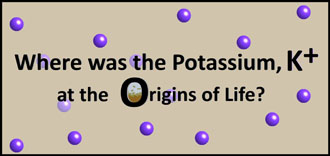Could life originate between the sheets of mica?
All living cells have high intracellular potassium concentrations, [K+].
How and when did this high [K+] appear?
All types of living cells have high intracellular potassium concentrations, [K+].
K+-dependent enzymes are typically intracellular, and Na+-dependent enzymes are typically extracellular. (1, 2)
When and how did this high [K+] appear? Was the prebiotic environment high in [K+]?
The ocean is not high in [K+]. Concentrations of Na+, [Na+], are 40 times as high as [K+] in the ocean.
There are 2 options for when high intracellular K+ might have appeared in living systems.
1. ‘Early K+’ : Life emerged in an environment with high [K+], or,
2. ‘Late K+’ : Life emerged in an environment without high [K+] and acquired high intracellular [K+] later.
There are problems with both options.
‘Late K+’ has the problem of how such an elemental aspect of life could have arisen after other processes in life’s origins had begun. The high intracellular [K+] is now maintained by energetically expensive pumps such as the Na/K-ATPase.
‘Early K+’ has the problem: where was the [K+]? Two possibilities have been published: in geothermal fields (3), and between the sheets of mica or biotite in micaceous clay. (4, 5)
Both of these options might have been true, if micaceous clay was present in geothermal fields, but there are also problems with these proposed sources of ‘Early K+’. The geothermal fields are described as ‘vapor-dominated,’ and there is not convincing data about the excesses of K+ over Na+ in geothermal fields. Mica was present in the Hadean, but most micaceous clay appeared on Earth at a later time. Advantages of mica are that mica’s anionic mineral sheets are held together by a hexagonal grid of K+, with a periodicity of 0.5 nm, which is also the spacing of anionic phosphate groups in extended single-stranded nucleic acids, DNA and RNA.
(1) M. J. V. Clausen, H. Poulsen, in Metallomics and the Cell. (Springer, 2013), pp. 41-67.
(2) M. J. Page, E. Di Cera, Role of Na+ and K+ in enzyme function. Physiological reviews 86, 1049-1092 (2006).
(3) A. Y. Mulkidjanian, A. Y. Bychkov, D. V. Dibrova, M. Y. Galperin, E. V. Koonin, Origin of first cells at terrestrial, anoxic geothermal fields. Proc Natl Acad Sci U S A 109, E821-830 (2012).
(4) H. G. Hansma, Did Biology Emerge from Biotite in Micaceous Clay? Preprints, (2020).
(5) H. G. Hansma, Possible origin of life between mica sheets. Journal of Theoretical Biology 266, 175-188 (2010).
This question, “Where was the K+?” is an elephant in the room of research on the origins of life.

Selected References : Potassium and the Origins of Life
- Campbell, T. D.; Hart, C. A.; Febrian, R.; Cheneler, M. L.; Bracher, P. J., The opposite effect of K+ and Na+ on the hydrolysis of linear and cyclic dipeptides. Tetrahedron Letters 2018, 59 (23), 2264-2267. PDF
Campbell, T. D.; Febrian, R.; McCarthy, J. T.; Kleinschmidt, H. E.; Forsythe, J. G.; Bracher, P. J., Prebiotic condensation through wet–dry cycling regulated by deliquescence. Nature communications 2019, 10 (1), 1-7. PDF
Dibrova, D.; Galperin, M. Y.; Koonin, E.; Mulkidjanian, A., Ancient systems of sodium/potassium homeostasis as predecessors of membrane bioenergetics. Biochemistry (Moscow) 2015, 80 (5), 495-516. PDF
Dubina, M. V.; Vyazmin, S. Y.; Boitsov, V. M.; Nikolaev, E. N.; Popov, I. A.; Kononikhin, A. S.; Eliseev, I. E.; Natochin, Y. V., Potassium ions are more effective than sodium ions in salt induced peptide formation. Origins of Life and Evolution of Biospheres 2013, 43 (2), 109-117. PDF
Korolev, N., How potassium came to be the dominant biological cation: of metabolism, chemiosmosis, and cation selectivity since the beginnings of life. BioEssays 2021, 43 (1), 2000108. PDF
Mulkidjanian, A. Y.; Bychkov, A. Y.; Dibrova, D. V.; Galperin, M. Y.; Koonin, E. V., Open questions on the origin of life at anoxic geothermal fields. Origins of Life and Evolution of Biospheres 2012, 42 (5), 507-516. PDF
Mulkidjanian, A. Y.; Bychkov, A. Y.; Dibrova, D. V.; Galperin, M. Y.; Koonin, E. V., Origin of first cells at terrestrial, anoxic geothermal fields. Proceedings of the National Academy of Sciences 2012, 109 (14), E821-E830. PDF
Raven, J. A., Origin of the roles of potassium in biology. BioEssays: 2021. PDF
Zhou, X.; Dalai, P.; Sahai, N., Semipermeable Mixed Phospholipid-Fatty Acid Membranes Exhibit K+/Na+ Selectivity in the Absence of Proteins. Life 2020, 10 (4), 39. PDF
Selected References : Potassium and the Origins of Life between Mica Sheets
H G Hansma, Possible Origin of Life between Mica Sheets. J Theor Biol 2010. 266, 175-188. PDF
H G Hansma, Possible Origin of Life between Mica Sheets: How Life Imitates Mica. 2013. J Biol Struct Dynamics, 31, 888-895. PDF H G Hansma, The Power of Crowding for the Origins of Life. 2014. Origins of Life and Evolution of Biospheres, 44, 307-311. PDF H G Hansma, Better than Membranes at the Origin of Life? 2017. Life, 7, 28. PDF H. Greenwood Hansma, Did Biology Emerge from Biotite in Micaceous Clay?, Preprints, 2020090409 PDFSelected References : Potassium in Biology, Chemistry and Biochemistry
-
Britto, D. T.; Coskun, D.; Kronzucker, H. J., Potassium physiology from Archean to Holocene: A higher-plant perspective. Journal of Plant Physiology 2021, 153432.
Epstein, W., The roles and regulation of potassium in bacteria. Progress in nucleic acid research and molecular biology 2003, 75, 293-320. Nishio, T.; Sugino, K.; Yoshikawa, Y.; Matsumoto, M.; Oe, Y.; Sadakane, K.; Yoshikawa, K., K+ promotes the favorable effect of polyamine on gene expression better than Na+. PloS one 2020, 15 (9), e0238447. Papahadjopoulos, D., Na+-K+ discrimination by “pure” phospholipid membranes. Biochimica et Biophysica Acta (BBA)-Biomembranes 1971, 241 (1), 254-259. Paula, S.; Volkov, A. G.; Van Hoek, A. N.; Haines, T. H.; Deamer, D. W., Permeation of protons, potassium ions, and small polar molecules through phospholipid bilayers as a function of membrane thickness. Biophysical Journal 1996, 70 (1), 339-48. Prelesnik, J. L.; Alberstein, R. G.; Zhang, S.; Pyles, H.; Baker, D.; Pfaendtner, J.; De Yoreo, J. J.; Tezcan, F. A.; Remsing, R. C.; Mundy, C. J., Ion-dependent protein–surface interactions from intrinsic solvent response. Proceedings of the National Academy of Sciences 2021, 118 (26). Russo, N.; Toscano, M.; Grand, A., Bond energies and attachments sites of sodium and potassium cations to DNA and RNA nucleic acid bases in the gas phase. Journal of the American Chemical Society 2001, 123 (42), 10272-10279. Thomas, M.; Jayatilaka, D.; Corry, B., The predominant role of coordination number in potassium channel selectivity. Biophysical journal 2007, 93 (8), 2635-2643. Williams, R., Tilden Lecture. The biochemistry of sodium, potassium, magnesium, and calcium. Quarterly Reviews, Chemical Society 1970, 24 (3), 331-365.
Last edited August 2021
